September 6, 2021 feature
Fast nanoparticle diffusion in synovial fluid and hyaluronic acid solutions
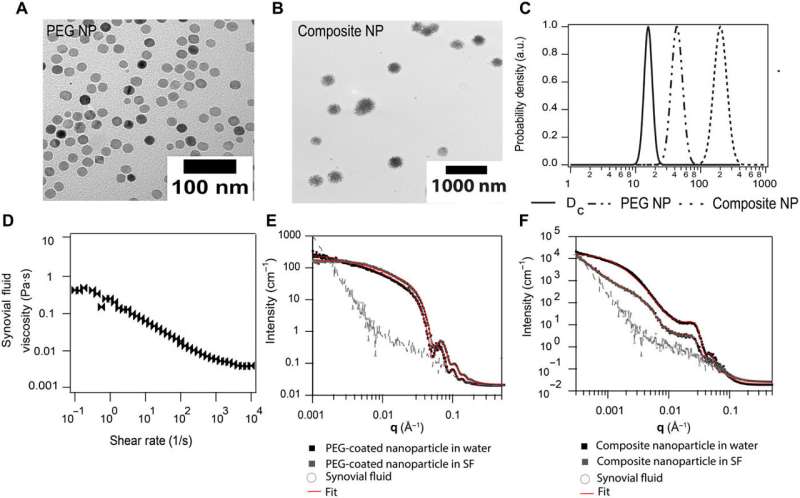
Nanoparticles have applications as therapeutic agents for joint diseases such as osteoarthritis. But the role of nanoparticle diffusion in synovial fluid or the fluid inside the joint is incompletely understood. In a new report now published on Science Advances, Mythreyi Unni and a research team in chemical engineering and biomedical engineering in the U.S. used the Stokes-Einstein relationship to describe the rotational and translational diffusion of polymer-coated nanoparticles in quiescent synovial fluid and hyaluronic acid solutions. The outcomes provided insight to the diffusive behavior of polymer-coated inorganic nanoparticles in complex aggregates of biological environments that are typically present in the joint.
Nanoparticles in the lab
Nanoparticles are therapeutic and diagnostic agents and researchers seek to understand their diffusion in biological fluids—key for clinical applications. The particles can be engineered to monitor and treat osteoarthritis, although their roles of diffusion in synovial fluids remain to be understood. In this work, Unni et al. studied the translational and rotational diffusion of colloidal, stableand neutral nanoparticles in bovine synovial fluid and in hyaluronic acid solutions, the latter of which constitutes a major component of synovial fluid in the joint. Particles can transfer in a fluid by convection and diffusion based on random thermal fluctuations described through their translational and rotational diffusivity as a function of particle and fluid properties. However, deviations from the Stokes-Einstein relations have occurred in such nanoparticles in solution. Nanoparticle diffusion in biological and polyelectrolyte solutions are therefore lacking and this information can form an essential guide to design nanoparticles for biomedical applications, including therapy and diagnosis of joint disease. Unni et al. used X-ray photon correlation spectroscopy measurements and dynamic magnetic susceptibility measurements and during the experiments, they ensured the colloidal stability of nanoparticles by coating them with polyethylene glycol. The outcomes of the study provided insight into the behavior of polymer-coated nanoparticles in biological environments.
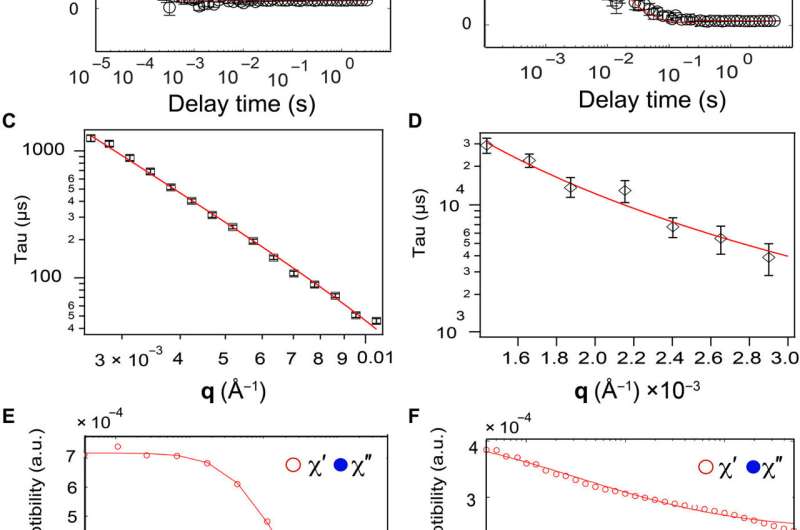
Diffusion of nanoparticles in synovial fluid
Unni et al. used polymer-coated cobalt ferrite nanoparticles of different hydrodynamic sizes during the study. The nanoparticles maintained an inorganic core diameter and a hydrodynamic diameter, which the team measured using transmission electron microscopy. The researchers used flash nanoprecipitation to prepare larger composite nanoparticles and studied their rotational diffusivities in bovine synovial fluid with rheological characterization studies. Using small-angle X-ray scattering measurements, they evaluated the structure and aggregation state of the nanoparticles in the synovial fluid. Unni et al. then studied the nanoparticles in synovial fluid using X-ray photon correlation spectroscopy, which suggested Brownian diffusion of the particles. When they subjected the materials to alternating magnetic fields, they responded by physical particle rotation, known as Brownian relaxation, which followed the Debye model. Dynamic magnetic susceptibility measurements of the coated nanoparticles in synovial fluid showed how larger substrates were more substantially restricted in the fluid. The team next studied the diffusion of nanoparticles in hyaluronic acid solutions—the major component of synovial fluid.
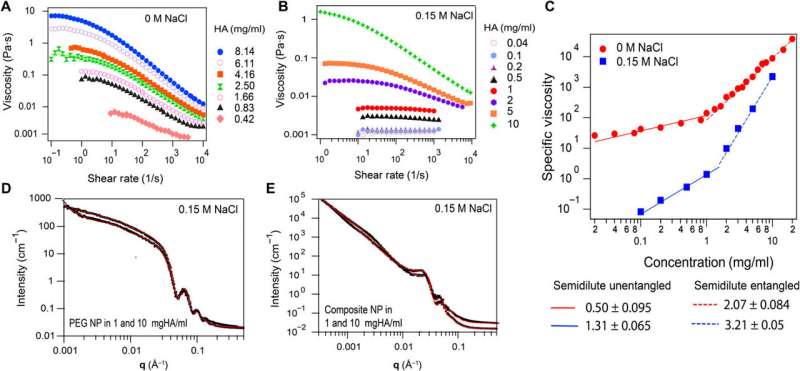
Diffusion of nanoparticles in hyaluronic acid solutions
The team further used hyaluronic acid and characterized them using rheometry and noted apparent Newtonian behavior for solutions with concentrations below 1 mg/mL. The team then conducted small-angle scattering X-ray spectroscopy measurements to study the structure and aggregation state of nanoparticles in hyaluronic acid solutions and in water. While the composite nanoparticles remained intact in water, the team noted broader polydispersity for nanoparticles in hyaluronic solutions. The nanoscale viscosity was distinct from the macroscopic low shear viscosity determined from rheometry. The rotational diffusion coefficients also differed for the two types of nanoparticles, where the values for the smaller nanoparticles were smaller than those for the larger composite particles. Based on the behavior of the nanoparticles, the team hypothesized the surrounding medium viscosity to be much larger than the solvent viscosity, which aligned with Albert Einstein's investigations on the theory of Brownian motion. However, in 1942, physicist Maurice L. Huggins modified Einstein's model to describe the viscosity of polymeric solutions, and the hypothesis presented in this work by Unni et al. agreed with the modified model.
-
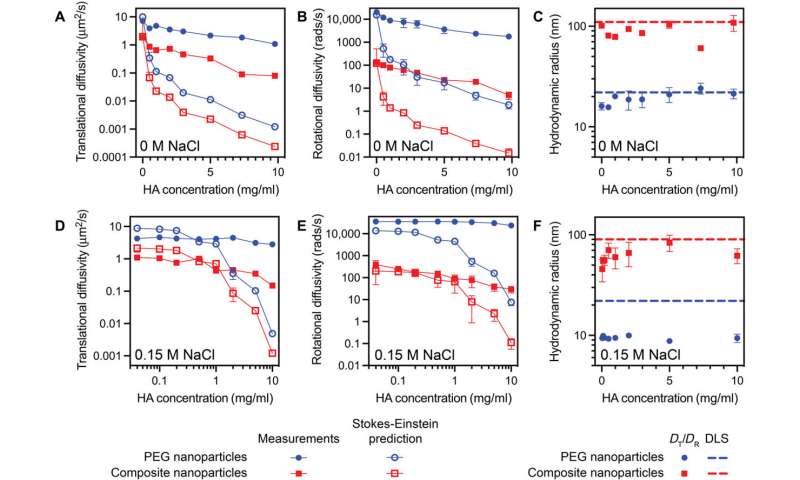
Nanoparticle translational and rotational diffusivities in HA solutions determined from XPCS and DMS measurements and predicted by the Stokes-Einstein equation. (A) Translational diffusion coefficients for HA solutions with 0 M NaCl. (B) Rotational diffusion coefficients for HA solutions with 0 M NaCl. (C) Hydrodynamic radii determined from the ratio of the experimentally determined translational and rotational diffusivities for HA solutions with 0 M NaCl. (D) Translational diffusion coefficients for HA solutions with 0.15 M NaCl. (E) Rotational diffusion coefficients for HA solutions with 0.15 M NaCl. (F) Hydrodynamic radii determined from the ratio of the experimentally determined translational and rotational diffusivities for HA solutions with 0.15 M NaCl. Observed agreement with hydrodynamic radii determined independently from DLS measurements suggests that the concentration-dependent diffusivity of the nanoparticles is well described by the functional form of the Stokes-Einstein relations. Credit: Science Advances, doi: 10.1126/sciadv.abf8467 -
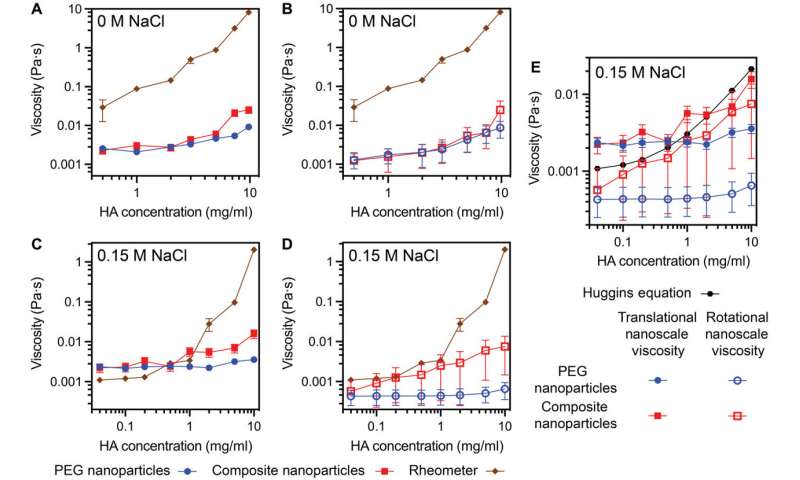
Nanoscale viscosity experienced by the nanoparticles determined from translational and rotation diffusion measurements, compared to macroscopic low shear viscosity. (A) Viscosities determined from translational diffusivities and rheometry for nanoparticles in HA solutions with 0 M NaCl. (B) Viscosities determined from rotational diffusivities and rheometry for nanoparticles in HA solutions with 0 M NaCl. (C) Viscosities determined from translational diffusivities and rheometry for nanoparticles in HA solutions with 0.15 M NaCl. (D) Viscosities determined from rotational diffusivities and rheometry for nanoparticles in HA solutions with 0.15 M NaCl. (E) Nanoscale viscosity experienced by the nanoparticles determined from the experimental translational and rotational diffusivity measurements and concentration-dependent viscosity of polymer using Huggins equation for PEG-coated and composite nanoparticles in HA with 0.15 M NaCl. Error bars tend to be smaller than markers. Credit: Science Advances, doi: 10.1126/sciadv.abf8467
Outlook
In this way, Mythreyi Unni and colleagues presented a reductionist approach to understand the transport of nanoparticles in a crowded and confined joint, by studying the diffusion of nanoparticles in synovial fluid and in hyaluronic acid solutions that typically constitute joint fluid. The composition and rheological properties of the fluid can vary with age and disease to influence nanoparticle diffusion. Additional studies with nanoparticles of a broader size range and coatings should be used to assess the transport of nanoparticles in porous cartilage and multilayered synovium. The team described the diffusion coefficient of the polymer-coated nanoparticles using the Stokes-Einstein relationship and followed this with descriptions of the viscosity of the medium using a model developed by Huggins. The work showed how the diffusive behavior of polymer-coated nanoparticles in biological fluid and their constituents can guide nanoparticle designs in biomedicine.
More information: Unni M. et al. Fast nanoparticle rotational and translational diffusion in synovial fluid and hyaluronic acid solutions, Science Advances, DOI: 10.1126/sciadv.abf8467
Nance E. et al. A dense poly(ethylene glycol) coating improves penetration of large polymeric nanoparticles within brain tissue. Science Translational Medicine, 10.1126/scitranslmed.3003594
J Topping, Investigations on the Theory of the Brownian Movement, Physics Bulletin (2015). DOI: 10.1088/0031-9112/7/10/012
Journal information: Science Advances , Science Translational Medicine
Provided by Science X Network
© 2021 Science X Network




















